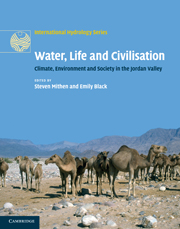Book contents
- Frontmatter
- Contents
- List of figures
- List of tables
- List of contributors
- Acknowledgements
- 1 Introduction: an interdisciplinary approach to Water, Life and Civilisation
- Part I Past, present and future climate
- Part II The palaeoenvironmental record
- Part III Hydrological studies of the Jordan Valley
- Part IV Human settlement, climate change, hydrology and water management
- Part V Palaeoeconomies and developing archaeological methodologies
- 20 The reconstruction of diet and environment in ancient Jordan by carbon and nitrogen stable isotope analysis of human and animal remains
- 21 Irrigation and phytolith formation: an experimental study
- 22 An investigation into the archaeological application of carbon stable isotope analysis used to establish crop water availability: solutions and ways forward
- 23 Past plant use in Jordan as revealed by archaeological and ethnoarchaeological phytolith signatures
- Part VI Society, economy and water today
- Part VII Conclusions
- Index
- Plate section
- References
23 - Past plant use in Jordan as revealed by archaeological and ethnoarchaeological phytolith signatures
from Part V - Palaeoeconomies and developing archaeological methodologies
Published online by Cambridge University Press: 26 April 2011
- Frontmatter
- Contents
- List of figures
- List of tables
- List of contributors
- Acknowledgements
- 1 Introduction: an interdisciplinary approach to Water, Life and Civilisation
- Part I Past, present and future climate
- Part II The palaeoenvironmental record
- Part III Hydrological studies of the Jordan Valley
- Part IV Human settlement, climate change, hydrology and water management
- Part V Palaeoeconomies and developing archaeological methodologies
- 20 The reconstruction of diet and environment in ancient Jordan by carbon and nitrogen stable isotope analysis of human and animal remains
- 21 Irrigation and phytolith formation: an experimental study
- 22 An investigation into the archaeological application of carbon stable isotope analysis used to establish crop water availability: solutions and ways forward
- 23 Past plant use in Jordan as revealed by archaeological and ethnoarchaeological phytolith signatures
- Part VI Society, economy and water today
- Part VII Conclusions
- Index
- Plate section
- References
Summary
ABSTRACT
Ninety-six phytolith samples were analysed from seven archaeological sites ranging from the Pre-Pottery Neolithic to the Classical period and from two ethnoarchaeological sites in Jordan. The aims were to test the possibility of detecting past irrigation with the methodology outlined by Madella et al. (2009) and Jenkins et al. (Chapter 21, this volume) and to study the contextual and temporal variation of plant use in Jordan. We utilised a water availability index using the proportion of phytolith types and ordination statistical methods to explore the similarities between the phytolith assemblages. The result of applying the irrigation methodology was promising, with contexts from water channels showing the greatest indication of water availability. Changes in plant use through time were also apparent with regard to phytolith densities and taxonomy. Date palm was identified in the Pottery Neolithic, providing one of the earliest records for this taxon in Jordan. This study shows the potential of both the water availability index and the value of inter-site comparison of phytolith assemblages.
INTRODUCTION
In this chapter phytolith analysis will be used to gain an understanding of past plant exploitation on a range of archaeological sites in Jordan dating from the Pre-Pottery Neolithic A (PPNA) to the Classical period. The broad aim of our analysis is to provide insights into past plant use in Jordan and to determine whether general patterns are observable through the phytolith record. One issue we wish to address is whether chronological changes in plant economy can be discerned.
- Type
- Chapter
- Information
- Water, Life and CivilisationClimate, Environment and Society in the Jordan Valley, pp. 381 - 400Publisher: Cambridge University PressPrint publication year: 2011
References
- 9
- Cited by



